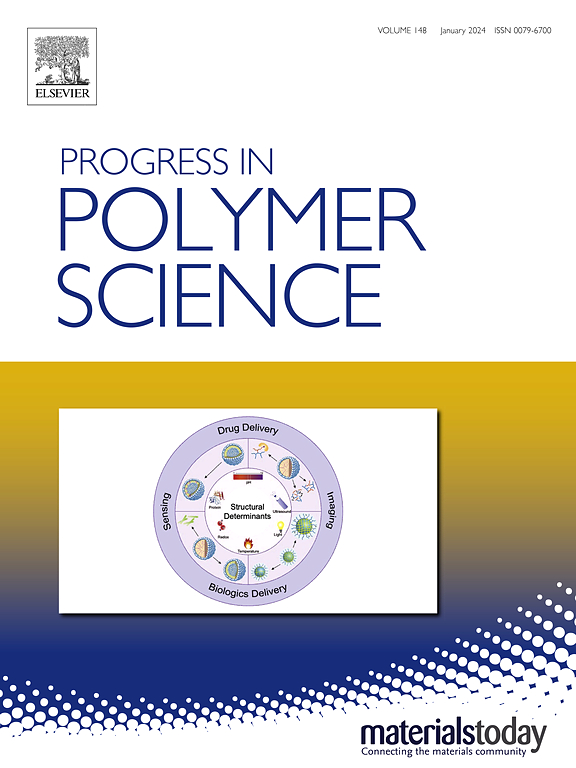聚(1,2,4-三唑)是新一代功能化聚离子液体
IF 26.1
1区 化学
Q1 POLYMER SCIENCE
引用次数: 0
摘要
本文综述了聚(1,2,4-三唑)离子液体这一新兴的聚离子液体的研究进展。与先前研究的聚咪唑和聚(1,2,3-三唑)s相比,我们强调了与氢键相关的独特结构特征,4环位置氮原子(N4)上的孤对相互作用以及形成聚碳烯的能力。虽然聚(1,2,4-三唑)的化学结构和合成路线相似,但这些特征使得聚(1,2,4-三唑)在物理化学性质、超分子化学和应用方面有别于其他聚(离子液体)基团。讨论了聚(1,2,4-三唑)的进一步发展所面临的挑战,包括合成的可扩展性和对其前沿应用性质的深入研究。本文章由计算机程序翻译,如有差异,请以英文原文为准。


Poly(1,2,4-triazolium)s as the rising generation of functional poly(ionic liquid)s
This article reviews the research field of poly(1,2,4-triazolium)s as a rising subclass of poly(ionic liquid)s. In comparison to previously studied polyimidazoliums and poly(1,2,3-triazolium)s, we highlight the unique structural features associated with the hydrogen bonds, the lone-pair interactions on the nitrogen atom at ring position 4 (N4) and the capacity to form polycarbenes. Though the chemical structures and the synthetic routes are alike, these features allow poly(1,2,4-triazolium)s to be distinct from other groups of poly(ionic liquid)s in terms of physical and chemical properties, supramolecular chemistry and applications. The challenges in the further development of poly(1,2,4-triazolium)s are discussed, including the scalability in synthesis and in-depth study of their properties for cutting-edge applications.
求助全文
通过发布文献求助,成功后即可免费获取论文全文。
去求助
来源期刊

Progress in Polymer Science
化学-高分子科学
CiteScore
48.70
自引率
1.10%
发文量
54
审稿时长
38 days
期刊介绍:
Progress in Polymer Science is a journal that publishes state-of-the-art overview articles in the field of polymer science and engineering. These articles are written by internationally recognized authorities in the discipline, making it a valuable resource for staying up-to-date with the latest developments in this rapidly growing field.
The journal serves as a link between original articles, innovations published in patents, and the most current knowledge of technology. It covers a wide range of topics within the traditional fields of polymer science, including chemistry, physics, and engineering involving polymers. Additionally, it explores interdisciplinary developing fields such as functional and specialty polymers, biomaterials, polymers in drug delivery, polymers in electronic applications, composites, conducting polymers, liquid crystalline materials, and the interphases between polymers and ceramics. The journal also highlights new fabrication techniques that are making significant contributions to the field.
The subject areas covered by Progress in Polymer Science include biomaterials, materials chemistry, organic chemistry, polymers and plastics, surfaces, coatings and films, and nanotechnology. The journal is indexed and abstracted in various databases, including Materials Science Citation Index, Chemical Abstracts, Engineering Index, Current Contents, FIZ Karlsruhe, Scopus, and INSPEC.
 求助内容:
求助内容: 应助结果提醒方式:
应助结果提醒方式:


